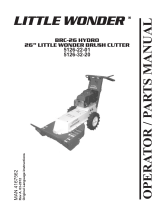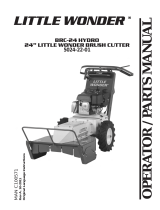2
THANK YOU
Thank you for purchasing a CLASSEN TRS-20/
TSS-20.
READ THIS MANUAL
Read this manual carefully in its entirety. It
contains assembly, operating, maintenance,
adjustment instructions and a parts list for your
TRS-20/TSS-20. By following the operating and
maintenance instructions you will prolong the life
of your equipment and maintain its maximum
efficiency. Failure to do so could result in personal
injury or equipment damage. This manual
should be considered a permanent part of your
TRS-20/TSS-20 and should remain with it if you
sell it.
WARRANTY
Refer to last page.
MEASUREMENTS
U.S. Units of measure are used in this manual.
SERIAL NUMBERS
Write frame and engine serial numbers, plus model
numbers in “Owner’s Record” section below. You
may need these numbers when you order parts.
The serial number sticker plate is located near
the left rear corner of the TRS-20/TSS-20 frame.
ORDERING PARTS
When ordering parts, always give the serial number
and model of your TRS-20/TSS-20 as well as the
quantity, part number and description of the part
needed.
DIRECTIONS
“Right Hand” and “Left Hand” sides of the
TRS-20/TSS-20 are determined by facing the “back”
of the unit as you would operate the machine.
TABLE OF CONTENTS
INTRODUCTION ......................................2
Thank You ............................................................2
Read This Manual ................................................2
Warranty................................................................2
Measurements ......................................................2
Serial Numbers......................................................2
Ordering Parts ......................................................2
Directions ..............................................................2
Pre-Delivery Check List ........................................3
Delivery Check List ..............................................3
Owner’s Record......................................................3
SAFETY PRECAUTIONS ..........................4
Training ................................................................4
Preparation Safety ................................................4
Engine Safety ........................................................4
Operational Safety ................................................4
OPERATION ..............................................5
Preparation ............................................................5
Starting Engine......................................................5
Transporting TURF RAKE/ TURF SEEDER..........5
Operating TURF RAKE/ TURF SEEDER ..............5
OPTIONAL BLADE ASSEMBLIES ............6
Changing Blade Assemblies ..................................6
Replacing Shaft Assembly Only ............................6
Recommended Height Adjustments......................6
GENERAL MAINTENANCE ......................8
TURF RAKE/ TURF SEEDER Maintenance ........8
Engine Maintenance..............................................8
MACHINE STORAGE ................................8
Storing TURF RAKE/ TURF SEEDER ..................8
Operation After Extended Storage ........................8
CARE FOR HYDRAULIC SYSTEM ............9
PARTS MAIN FRAME ASSEMBLY ..........10
PARTS SELF PROPELLED ASSEMBLY ....11
PARTS HANDLE ASSEMBLY ....................12
SEEDER/MULTIPURPOSE
BLADE ASSEMBLY ..................................13
SLICER BLADE ASSEMBLY ....................13
SEED BOX ASSEMBLY ............................14
SEEDER TIRE SCRAPE INSTALLATION 15
SEED BOX INSTALLATION ....................15
SAFETY DECALS ....................................16
NOTES ....................................................17
WARRANTY ............................................18
INTRODUCTION
























